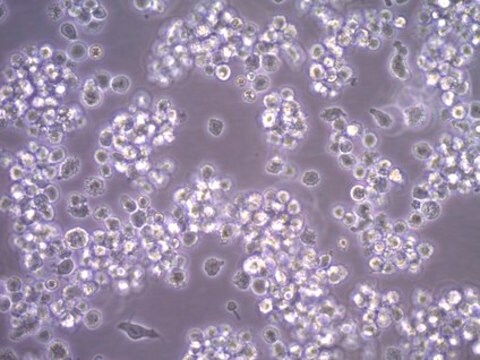MABF2049
Anti-LTBR Antibody, clone 3C8
clone 3C8, from rat
Synonim(y):
Tumor necrosis factor receptor superfamily member 3, Lymphotoxin-beta receptor
About This Item
Polecane produkty
pochodzenie biologiczne
rat
Poziom jakości
forma przeciwciała
purified immunoglobulin
rodzaj przeciwciała
primary antibodies
klon
3C8, monoclonal
reaktywność gatunkowa
mouse
metody
flow cytometry: suitable
izotyp
IgG1κ
numer dostępu NCBI
numer dostępu UniProt
Warunki transportu
ambient
docelowa modyfikacja potranslacyjna
unmodified
informacje o genach
mouse ... Ltbr(17000)
Powiązane kategorie
Opis ogólny
Specyficzność
Immunogen
Zastosowanie
Flow Cytometry Analysis: A representative lot detected LTBR in Flow Cytometry applications (Yi, T., et. al. (2013). Elife. 2:e00757).
Agonist or Inhibitor Analysis: A representative lot detected LTBR in Agonist or Inhibitor applications (Dejardin, E., et. al. (2002). Immunity. 17(4):525-35).
Agonist or Inhibitor Analysis: A representative lot detected LTBR in Agonist or Inhibitor applications (Vondenhoff, M.F., et. al. (2009). J Immunol. 182(9):5439-45).
Agonist or Inhibitor Analysis: A representative lot detected LTBR in Agonist or Inhibitor applications (Yi, T., et. al. (2013). Elife. 2:e00757).
Agonist or Inhibitor Analysis: A representative lot detected LTBR in Agonist or Inhibitor applications (Banks, T.A., et. al. (2005). J Immunol. 174(11):7217-25).
Inflammation & Immunology
Jakość
Flow Cytometry Analysis: 1 µg of this antibody detected LTBR in one million NIH/3T3 cells.
Opis wartości docelowych
Postać fizyczna
Przechowywanie i stabilność
Inne uwagi
Oświadczenie o zrzeczeniu się odpowiedzialności
Nie możesz znaleźć właściwego produktu?
Wypróbuj nasz Narzędzie selektora produktów.
Kod klasy składowania
12 - Non Combustible Liquids
Klasa zagrożenia wodnego (WGK)
WGK 1
Certyfikaty analizy (CoA)
Poszukaj Certyfikaty analizy (CoA), wpisując numer partii/serii produktów. Numery serii i partii można znaleźć na etykiecie produktu po słowach „seria” lub „partia”.
Masz już ten produkt?
Dokumenty związane z niedawno zakupionymi produktami zostały zamieszczone w Bibliotece dokumentów.
Nasz zespół naukowców ma doświadczenie we wszystkich obszarach badań, w tym w naukach przyrodniczych, materiałoznawstwie, syntezie chemicznej, chromatografii, analityce i wielu innych dziedzinach.
Skontaktuj się z zespołem ds. pomocy technicznej



